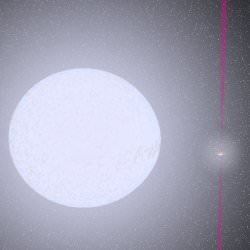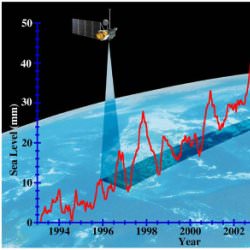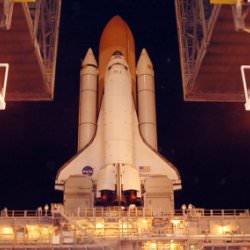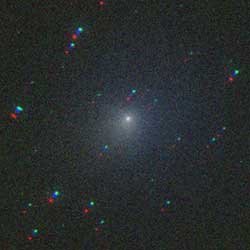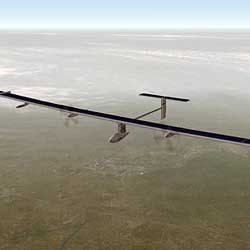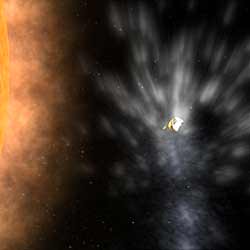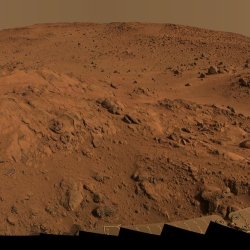
Panoramic view of Mars taken by NASA’s Spirit rover. Image credit: NASA/JPL. Click to enlarge.
Mars is a rocky planet with an ancient volcanic past, but new findings show the planet is more complex and active than previously believed – at least in certain places.
Finding those places, however, turns out to be trickier than just looking at landforms like river valleys or lakebeds or searching for specific minerals.
“Context is everything,” said Philip Christensen, Principal Investigator for the Thermal Emission Spectrometer (TES) on Mars Global Surveyor and for the Thermal Emission Imaging System (THEMIS) on Mars Odyssey, as well as lead scientist for the Mini-TES instruments on the Mars Exploration Rovers. “There has been a lot of excitement about finding specific features or minerals, but THEMIS, together with the TES infrared spectrometer, is giving us an overview by finding all the minerals. It gives us context – the underlying geology of the place.”
A paper led by Christensen, to be released online by the journal Nature on July 6, describes how a detailed examination of the Red Planet’s surface minerals using THEMIS and TES data yields surprising results in certain localized areas.
While the current rover missions have largely proved that in the distant past Mars may have had a lake or two, several different orbital mapping missions have found a basalt-rich planet that is the product of an ancient volcanic history. Geologically, it seems like a simple planet in the large scale – but then there are local windows showing far more complexity.
“From what we have seen to date, you might imagine going to Mars and seeing nothing but basalt,” said Christensen. “The evidence has always shown that the planet was active early, made some big volcanoes and then shut down and that was that. But when we looked more carefully we saw that there are these other places?When you look at the geology in the right spots, there is as much diversity in the rocks as you see on Earth.
“Once you get a glimpse of this complexity, you realize that there is a very complex world underneath that veneer of basalt.”
What Christensen and team found were localized deposits showing a distribution of igneous mineral types rivaling the range of minerals found on Earth – from primitive volcanic rocks like olivine-rich basalts to highly processed silica-rich rocks like granites.
The diversity of igneous minerals is important, Christensen explains, because it implies that the surface rocks have continued to be processed and reconstituted multiple times over an extended period of time.
“You melt the mantle and you get olivine basalts; you melt them again and you get basalt; you melt that and you make andesite; you melt that and you make dacite; you melt that and you make granite,” said Christensen. “Every time you re-melt a rock, the first thing to come off is the silica, so each time you melt it, you’re refining the silica.”
On Earth, such mineral evolution generally occurs as primitive volcanic rocks get folded back into the planet’s crust, re-melted and refined as faster melting components like silica separate out of the original material – a process known as mineral fractionation.
Mars, unlike Earth, does not have moving plates recycling the planet’s crust. However, Christensen’s results show that, like Earth, Mars has evolved and may still be evolving beneath the surface.
“Mars is a more complicated planet than we thought – the geology has kept chugging along and evolving over time,” Christensen said. “Though they’re not widespread, we’ve found dacite, and we’ve found granite. One way to make these granites is to make a whole volcano stacked up out of basalt – it gets tall enough and you begin to remelt the stuff deep down, and when you remelt the basalt, you can have granites forming.
“These are fairly small occurrences. On Earth, we have mountain ranges made of granite, on Mars we have so far only found a couple of globs. It’s not like the Earth in the extent of this geological evolution, but Mars is like the Earth in localized situations. It’s been hidden from us, but it’s a sophisticated, evolving planet after all,” he said.
Because the areas where the evolved igneous rocks occur are small, it has taken the high-resolution multispectral camera in Mars Odyssey’s THEMIS instrument (with a resolution of 100 meters) to find the minerals from orbit by finding a specific infrared signature in specific landforms. THEMIS’s mineral mapping has been 1500 times more detailed than TES’s, though the TES instrument’s infrared spectrometer (with a resolution of 3 kilometers) detects a much more detailed range of infrared emissions, making it more sensitive to different mineral compositions.
“We’re doing the thing that we set out to do: mapping the composition at mesoscales,” Christensen noted. “THEMIS identifies the area, then we go back and find what may be just a single, over-looked TES pixel and analyze it. The two were really planned to work together and that’s exactly what we’ve been doing. We use these two instruments in a synergistic way and together they’re perfect.”
Though Mars mapping has been going on for many years, Christensen notes that some of the most interesting places on the planet have yet to be identified and explored.
“If you drained the Earth’s oceans and looked at it from space, you would probably reach the same conclusion – a quiet, basaltic planet,” he said. “But then, if you searched carefully, you might find Yellowstone and realize that there was a lot going on below the surface of the planet that you weren’t aware of. We’re at that stage now in looking at Mars.”
Original Source: NASA Astrobiology

